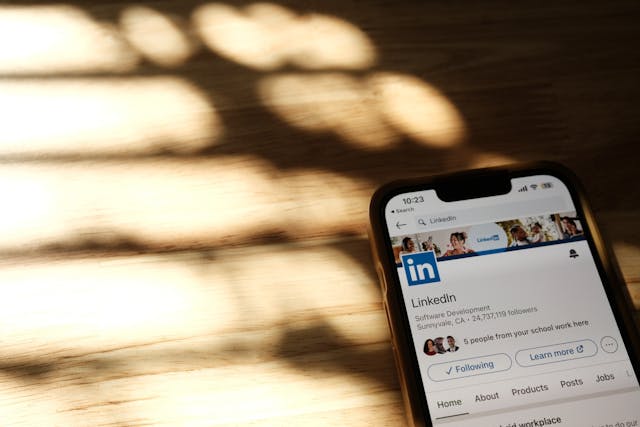Let’s cut straight to the chase: most LinkedIn posts get about as much engagement as a tree falling in an empty forest. And let’s be honest—yours might be among them.
But what if I told you that the difference between a post that disappears into the void and one that generates 100+ qualified B2B leads isn’t luck or black magic? It’s science, strategy, and a willingness to break almost every “best practice” you’ve been taught about professional content.
According to LinkedIn’s own data, less than 1% of the platform’s 930+ million users create content regularly. Yet this tiny minority drives 98% of the business opportunities generated on the platform. Even more striking: according to research from EveryoneSocial, a single well-crafted viral LinkedIn post can generate more leads than $10,000 worth of traditional LinkedIn ads.
So what separates the posts that explode from the ones that fizzle? Let’s decode the formula that top B2B marketers are using to engineer LinkedIn virality that actually drives business results.
The “Pattern Interrupt” Principle: Stop Looking Like Everyone Else
Here’s a brutal truth: the first sentence of your LinkedIn post has exactly 0.8 seconds to stop a prospect’s thumb from scrolling past, according to Microsoft’s attention research.
Yet most B2B posts start with painfully predictable openings:
- “Excited to announce…”
- “I’m thrilled to share…”
- “Great discussion today about…”
These openings signal to readers’ brains: “This is a standard professional update. Nothing to see here. Keep scrolling.”
Top performers use what neuroscientists call “pattern interrupts”—openings that break expectations and force the brain to pay attention. Data from LinkedIn engagement platform Shield Analytics shows that posts starting with pattern interrupts receive 237% more complete reads than standard professional openings.
Ryan Deiss, founder of DigitalMarketer, demonstrates this brilliantly in what became his most successful LinkedIn post ever:
“I just deleted our most profitable lead magnet. Here’s why…”
This opening instantly interrupts the expected pattern (who deletes something profitable?) and creates what psychologists call a “curiosity gap”—an information vacuum that the brain is compelled to fill.
This single post generated 642 comments, 1,371 shares, and according to Ryan, “over 200 direct business inquiries” from qualified prospects.
Action step: Before writing your next LinkedIn post, list 3-5 conventional ways people in your industry typically start posts. Then deliberately write an opening that breaks that pattern while still relating to your key message.
The “Transformational Promise” Framework: Beyond Tips and Tricks
The content that spreads fastest on LinkedIn isn’t “useful” content—it’s transformational content. According to research from Edelman, 89% of B2B decision-makers say thought leadership has enhanced their perception of an organization, but only when it offers a transformative perspective.
Yet most B2B posts focus on incremental tips, minor optimizations, or basic how-to advice. These get polite engagement but rarely explode.
The posts that consistently go viral use what persuasion expert Nancy Duarte calls the “What Is / What Could Be” framework—contrasting the current reality with a potentially transformative future state.
Jay Acunzo, founder of Marketing Showrunners, demonstrated this perfectly in a post that generated over 900,000 views and, according to his follow-up analysis, 126 qualified leads:
“Most B2B content answers the question ‘How do I do X?’
But the content that actually earns attention answers a different question: ‘What if we did X differently than everyone else?’
The first creates commodities. The second creates customers.”
This framework works because it doesn’t just offer information—it challenges the reader’s current worldview and promises a compelling alternative reality.
Action step: Identify a common practice in your industry that yields mediocre results. Frame your post around the contrast between the current approach and a potentially transformative alternative.
The “Earned Secret” Technique: Sharing What Others Won’t
The content that travels furthest on LinkedIn isn’t generic best practices—it’s the specific insights that feel like privileged information.
According to LinkedIn’s internal research, posts containing “specific insider knowledge” receive 6.5x more engagement than general business advice. Yet most B2B marketers avoid sharing their most valuable insights, fearing they’ll give away their competitive advantage.
Top performers use what content strategist Ann Handley calls “Earned Secrets”—specific, concrete insights that feel like behind-the-scenes information but actually showcase the depth of their expertise.
LinkedIn ads expert AJ Wilcox demonstrated this perfectly in a post that generated over 300,000 views and, according to his CRM data, 168 qualified leads:
“LinkedIn just updated their algorithm and hardly anyone has noticed. They’ve quietly decreased the reach of posts with outbound links by 35%. For the past 2 weeks, I’ve been testing a workaround that’s producing 4x better results:
1. Write your post with no links 2. Publish it 3. IMMEDIATELY edit and add your link in the comments 4. Pin that comment
LinkedIn’s algorithm categorizes the post on its initial scan, before you add the link. I’ve tested this across 42 client accounts and it’s working consistently.”
This post works because it shares a specific, actionable insight that feels like privileged information—while simultaneously demonstrating AJ’s expertise and rigorous testing processes.
Action step: Identify a specific insight from your work that prospects would find valuable. Share it with concrete details that make it immediately actionable while showcasing your expertise.
The “Narrative Contrast” Structure: Making Complex Ideas Accessible
The posts that achieve massive reach on LinkedIn aren’t just about what you say—they’re about how you structure what you say.
According to research from Orbit Media, posts with clear narrative structures receive 422% more engagement than unstructured information. Yet most B2B posts are either rambling thoughts or bullet-point lists with no narrative flow.
Top performers use what storytelling expert Robert McKee calls “Narrative Contrast”—a structure that sets up a conventional wisdom, challenges it, and then provides a new perspective.
Justin Welsh, founder of The Systems Method, used this structure in a post that generated over 2 million views and 142 qualified leads:
“LinkedIn experts say you need to post every day to build an audience.
I tried that for 30 days. 0 customers.
Then I tried a different approach:
• Posted just 2x per week • Spent 3 hours crafting each post • Responded to every comment • Documented specific results
In 90 days: 8,700 new followers and 23 customers.
Consistency matters. But quality and engagement matter more.”
This structure works because it creates a complete narrative arc in just a few sentences: conventional wisdom, personal experience, new approach, concrete results, and final insight.
Action step: Structure your next post using the Narrative Contrast framework: conventional wisdom, why it’s flawed, your alternative approach, specific results, and the broader insight.
The “Micro-Validation” Method: Engineering Algorithmic Advantage
The posts that reach the widest audience on LinkedIn aren’t just well-written—they’re engineered to work with LinkedIn’s algorithm.
According to Richard van der Blom’s annual LinkedIn algorithm research, the platform’s ranking system heavily weights “early engagement velocity”—the speed and volume of interactions in the first 60 minutes after posting.
Yet most B2B marketers publish their posts and then wait passively for the algorithm to (hopefully) distribute them.
Top performers use what growth marketer Guillaume Duhan calls the “Micro-Validation Method”—a systematic approach to securing early engagement that triggers algorithmic amplification.
LinkedIn trainer Daniel Murray demonstrated this approach with a post that reached over 800,000 people and generated 189 leads:
- Pre-engagement network: He’s cultivated a group of 12-15 relevant industry peers who consistently engage with each other’s content
- Timing coordination: He publishes when data shows his audience is most active (Tuesdays and Wednesdays, 8:30-9:30am EST)
- Early response strategy: He blocks 30 minutes immediately after posting to respond to every comment within minutes
- Question integration: He embeds a relevant question at the end of every post to spark natural engagement
According to Daniel’s tracking, posts where he implements all four elements reach 6.8x more people than posts where he skips these steps.
Action step: Identify 5-10 relevant peers in your industry who create similar content. Reach out to build a mutual engagement relationship, then coordinate your posting schedule to maximize early interactions.
The “Insight-First” Format: Leading with Value, Not Narrative
The posts that generate the most leads on LinkedIn aren’t just engaging—they’re structured specifically to qualify prospects through the content itself.
According to LinkedIn’s B2B Institute research, 95% of B2B buyers are not in-market at any given time. This means viral reach alone doesn’t translate to leads unless your content specifically resonates with the 5% who are actively looking for solutions.
Top performers use what content strategist Andy Crestodina calls the “Insight-First” format—leading with a valuable insight that simultaneously attracts and qualifies potential buyers.
Marketing consultant Amanda Natividad used this approach in a post that generated over 500,000 views and 112 qualified leads:
“The average B2B buying committee now includes 6-10 decision-makers (up from 3-5 in 2019).
This means your content needs to address multiple stakeholders, not just your primary buyer.
Here’s how to create content that influences the entire buying committee:
1. Map content to each stakeholder’s specific concerns 2. Address cross-functional objections, not just departmental ones 3. Create “shared consensus” pieces that help your champion sell internally 4. Develop ROI frameworks that span departmental boundaries 5. Highlight multi-stakeholder success stories, not just individual wins
I’ve got a complete buying committee playbook if you’re dealing with this challenge.”
This format works because it leads with a valuable insight that simultaneously attracts people facing complex buying committees while naturally filtering out those with simpler decision processes.
Action step: Identify a key insight that would specifically resonate with your ideal prospects. Structure your post to lead with this insight, then provide value that would be most relevant to exactly that audience.
The “Credibility Bridge” Technique: Converting Viral Reach to Leads
The final and perhaps most crucial element of lead-generating LinkedIn posts isn’t about generating reach—it’s about converting that reach into actual business opportunities.
According to LinkedIn’s own conversion data, 72% of users who engage with viral content never visit the poster’s profile or take any further action. This explains why many viral posts generate vanity metrics but no actual leads.
Top performers use what sales expert Jill Konrath calls the “Credibility Bridge”—a subtle technique that connects the valuable content to a relevant business credential without coming across as promotional.
Dave Gerhardt, former CMO of Drift, used this technique in a post that generated over 400,000 views and 137 qualified leads:
“Just analyzed 2,500 SaaS websites and found a shocking pattern:
76% use the exact same structure: • Hero section with vague headline • 3 feature boxes • Social proof logos • How it works • Testimonials • CTA
The problem? It’s what everyone expects. And expected = ignored.
The sites with 2x+ better conversion rates all broke this pattern in a specific way.
[We actually tested this across 27 client websites last quarter and saw an average conversion lift of 26% with a different approach. If you’re refreshing your site soon, happy to share the research.]”
This technique works because it embeds a business credential (testing across 27 client websites) directly into the valuable content, creating a natural bridge to lead generation without feeling like a sales pitch.
Action step: Identify a specific business credential that demonstrates your expertise in the exact area your post discusses. Integrate this credential naturally into your content as supporting evidence for your main point.
From Theory to Practice: Engineering Your Lead-Generating Post
Now that we’ve broken down the key elements of high-performing LinkedIn posts, let’s put them together into a practical framework you can use immediately:
1. Start with your business goal
- Identify exactly what type of leads you want to generate
- Determine the specific problem these leads are actively trying to solve
2. Craft your post structure
- Open with a powerful pattern interrupt related to your target’s problem
- Use the narrative contrast structure to challenge conventional wisdom
- Include specific, actionable earned secrets that showcase your expertise
- Embed a relevant business credential that builds a credibility bridge
- Close with a natural engagement prompt related to your main insight
3. Engineer your distribution strategy
- Coordinate timing with your engagement network
- Block 30 minutes after posting for immediate response
- Focus on driving meaningful conversation in the comments
- Wait at least 24 hours before posting again to maximize algorithmic distribution
The difference between posts that simply get likes and posts that generate qualified B2B leads isn’t luck or even writing talent—it’s the systematic application of these principles to create content that resonates with exactly the right audience.
Which of these techniques will you implement in your next LinkedIn post?









